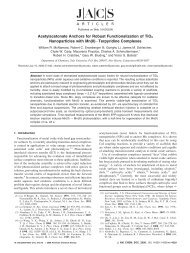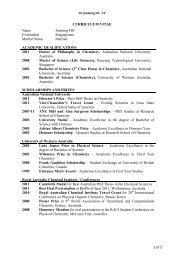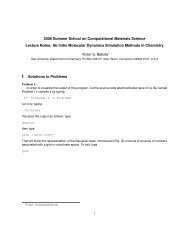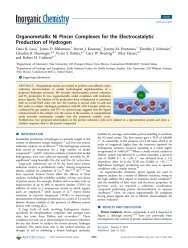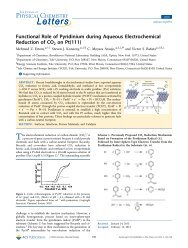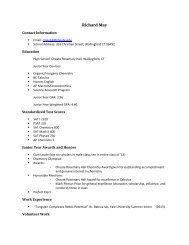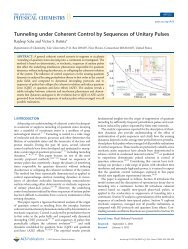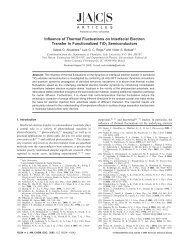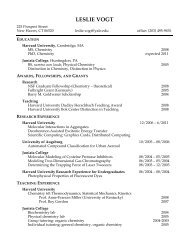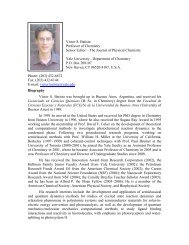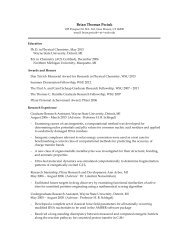Kepler PredictorâCorrector Algorithm - Yale Chemistry - Yale ...
Kepler PredictorâCorrector Algorithm - Yale Chemistry - Yale ...
Kepler PredictorâCorrector Algorithm - Yale Chemistry - Yale ...
You also want an ePaper? Increase the reach of your titles
YUMPU automatically turns print PDFs into web optimized ePapers that Google loves.
Journal of Chemical Theory and Computation<br />
M and e, where each Halley’s iteration is followed by a Newton<br />
Raphson optimization. The iterative scheme typically converges<br />
to machine accuracy in about three iterations. 37 The initial guess<br />
ε (0) a is obtained, as follows:<br />
Elliptic <strong>Kepler</strong> Equation. For elliptic motion (0 e M e π and<br />
0 e e e 1) and small M, we expand the sin function in eq 56 to<br />
third order, and the resulting approximation of M is substituted<br />
in eq 55, giving a cubic approximation of the elliptic <strong>Kepler</strong><br />
equation:<br />
0 ¼ ε 3 00 þ 3qε 00 2r ð58Þ<br />
where q = 2(1 e)/e and r =3M/e. Solving eq 58, we obtain<br />
2r<br />
ε 00 ¼<br />
c 2 v þ q ð59Þ<br />
þðq=wÞ2<br />
where c v =((r 2 + q 3 ) 1/2 + r) 1/3 . On the other hand, for large M,a<br />
good initial guess is<br />
ε 01 ¼ M<br />
Therefore, we define an initial guess that is valid for intermediate<br />
values of M, asanM-weighted average of the small M guess ε 00<br />
and the large M guess ε 01 :<br />
ε ð0Þ<br />
a ¼ 1 π ðM ε 01 þðπ MÞε 00 Þ ð60Þ<br />
¼ 1 π ðM2 þðπ MÞε 00 Þ ð61Þ<br />
Hyperbolic <strong>Kepler</strong> Equation. For hyperbolic motion (M >0<br />
and 1 e e) with small M, the sinh function in eq 56 is expanded to<br />
third order, and the resulting approximation of M is introduced<br />
into eq 55 to give the cubic approximation to the hyperbolic<br />
<strong>Kepler</strong> equation:<br />
0 ¼ ε 3 00 þ 3qε 00 2r ð62Þ<br />
where q =2(e 1)/e and r =3M/e, with the same formal solution<br />
introduced by eq 59, although there are different values of q and r.<br />
Bounded coefficients are obtained through an iterative procedure<br />
based on the hyperbolic equation divided by e, as follows:<br />
0 ¼ M ε þ e sinh½εŠ ð63Þ<br />
0 ¼ L gε þ sinh½εŠ ð64Þ<br />
with L = M/e and g =1/e. For large L, a good initial guess is<br />
ε 01 ¼ sinh 1 L<br />
ð65Þ<br />
which is again mixed with ε 00 , as follows:<br />
ε ð0Þ<br />
a ¼ M ε 01 þ 1 ε 00<br />
M þ 1<br />
¼ M sinh 1 L þ ε 00<br />
M þ 1<br />
3. ELECTRON SCATTERING<br />
ð66Þ<br />
ð67Þ<br />
3.1. Time-Dependent Wigner Transform. This section<br />
illustrates the capabilities of the KPC algorithm, introduced in<br />
section 2, as applied to semiclassical dynamics simulations of<br />
electron proton scattering processes in the Wigner-transform<br />
ARTICLE<br />
time-dependent picture. Simulations consider the problem of<br />
electron scattering from stationary protons, as described within<br />
the Born Oppenheimer approximation (i.e., with m = m e and<br />
the Coulombic parameter γ = 1 au, so that μ = γ/m = 1 au).<br />
The initial state for the scattering electron is defined by the<br />
three-dimensional Gaussian:<br />
!<br />
ψ 0 ðxÞ ¼ð2πσ 2 Þ 3=4 ðx x 0 Þ 2<br />
exp<br />
4σ 2 þ i p p 0 ðx x 0Þ ð68Þ<br />
with average position x 0 and momentum p 0 . The corresponding<br />
Wigner transform: 39<br />
P 0 ðx, pÞ ¼ 1 <br />
Z ∞<br />
ð2πpÞ 3 ∞ ψ 0 x þ s <br />
s<br />
ψ<br />
2 0 x e ip 3 s ds ð69Þ<br />
2<br />
" #<br />
1<br />
¼<br />
ð2πpσ x σ p Þ 3 exp ðx x 0 Þ 2 ðp p 0 Þ 2<br />
2σ 2 x 2σ 2 ð70Þ<br />
p<br />
defines the initial phase-space distribution function, where σ x = σ<br />
and σ p is defined by the uncertainty relation σ x σ p = p/2.<br />
The full quantum-mechanical Wigner distribution P QM t (x,p)is<br />
computed as<br />
<br />
Pt<br />
QM 1<br />
Z ∞<br />
ðx, pÞ ¼<br />
ð2πpÞ 3 ∞ ei=pp 3 s ψ t x þ s <br />
ψ<br />
2 t x<br />
<br />
s<br />
2<br />
ds<br />
ð71Þ<br />
where ψ t is the solution of the time-dependent Schr€odinger<br />
equation<br />
!<br />
ip ∂ ∂t ψ tðxÞ ¼ ^p2 þ VðxÞ<br />
2m e<br />
ψ t ðxÞ<br />
ð72Þ<br />
with<br />
VðxÞ ¼<br />
q j<br />
jx R j j<br />
ð73Þ<br />
∑<br />
j<br />
where the sum is over all protons j, with charge q j =+e, and<br />
coordinates R j . ψ t (x) is represented on a three-dimensional grid<br />
and propagated according to the standard Split Operator Fourier<br />
Transform (SOFT) method. 40,41 The grid is defined as follows:<br />
x αk = x α0 + kΔx, k = 1, 2, ..., 128, where α =1 3 enumerates the<br />
Cartesian directions, x 10 = 4 Å, and x 20 = x 30 = 5 Å. The grid<br />
spacings Δx = 10/128 Å and Δt =10 4 fs define a sufficiently fine<br />
space time grid that ensures an accurate representation of the<br />
oscillatory structure of ψ t (x), even during high-energy collisions<br />
(e.g., collisions with tens of electronvolts). The full-quantum<br />
propagation is based on the short-time Trotter approximation of<br />
the time-evolution operator:<br />
ψ tþΔt ðxÞ ¼Uðt, t þ ΔtÞ ψ t ðxÞ<br />
ð74aÞ<br />
≈ e i=pVΔt=2 e i=p^p2 =2m eΔt e i=pVΔt=2 ψ t ðxÞ<br />
ð74Þ<br />
The time-evolved semiclassical Wigner distribution P SC t (x,p) is<br />
computed as follows:<br />
Z ∞<br />
Pt<br />
SC ðx, pÞ ¼ð2πÞ 3 ds<br />
∞<br />
Z ∞<br />
∞<br />
Z ∞<br />
dp 0 dx 0 e iðp<br />
∞<br />
p t Þs δðx t xÞ P 0 ðx 0 , p 0 Þ<br />
ð75aÞ<br />
¼ 1 N ∑N δðp p t ðjÞÞ δðx t ðjÞ xÞ ð75Þ<br />
j ¼ 1<br />
where x t (j) andp t (j) are coordinates and momenta, obtained by<br />
classical KPC propagation. The initial coordinates and momenta<br />
29 dx.doi.org/10.1021/ct200452h |J. Chem. Theory Comput. 2012, 8, 24–35



